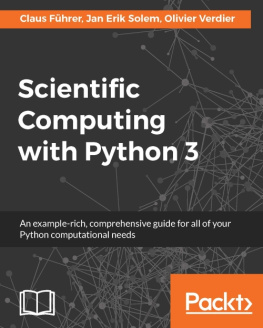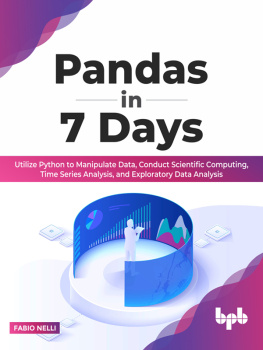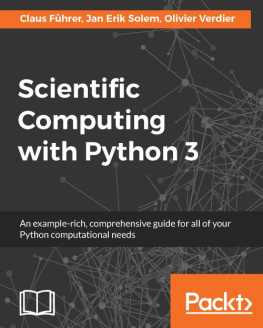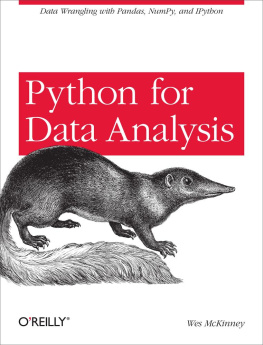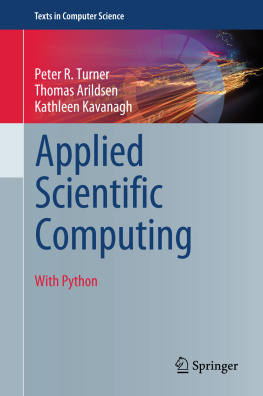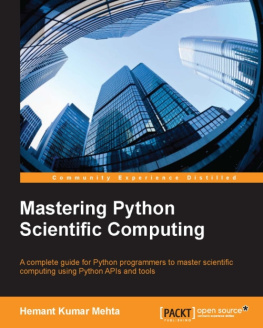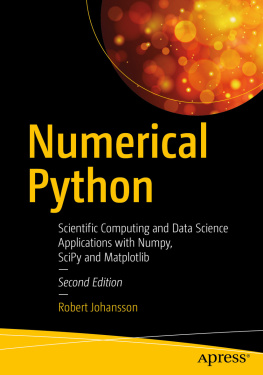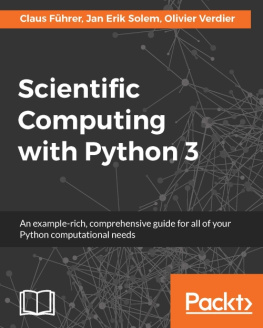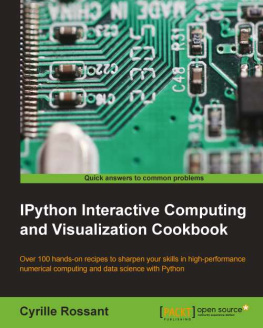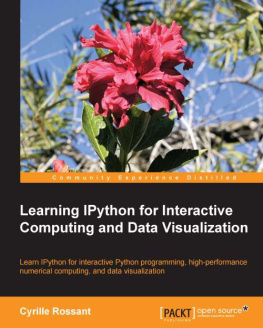Olivier Verdier - Scientific Computing with Python 3
Here you can read online Olivier Verdier - Scientific Computing with Python 3 full text of the book (entire story) in english for free. Download pdf and epub, get meaning, cover and reviews about this ebook. year: 2018, publisher: Packt Publishing, genre: Home and family. Description of the work, (preface) as well as reviews are available. Best literature library LitArk.com created for fans of good reading and offers a wide selection of genres:
Romance novel
Science fiction
Adventure
Detective
Science
History
Home and family
Prose
Art
Politics
Computer
Non-fiction
Religion
Business
Children
Humor
Choose a favorite category and find really read worthwhile books. Enjoy immersion in the world of imagination, feel the emotions of the characters or learn something new for yourself, make an fascinating discovery.
- Book:Scientific Computing with Python 3
- Author:
- Publisher:Packt Publishing
- Genre:
- Year:2018
- Rating:5 / 5
- Favourites:Add to favourites
- Your mark:
- 100
- 1
- 2
- 3
- 4
- 5
Scientific Computing with Python 3: summary, description and annotation
We offer to read an annotation, description, summary or preface (depends on what the author of the book "Scientific Computing with Python 3" wrote himself). If you haven't found the necessary information about the book — write in the comments, we will try to find it.
Scientific Computing with Python 3 — read online for free the complete book (whole text) full work
Below is the text of the book, divided by pages. System saving the place of the last page read, allows you to conveniently read the book "Scientific Computing with Python 3" online for free, without having to search again every time where you left off. Put a bookmark, and you can go to the page where you finished reading at any time.
Font size:
Interval:
Bookmark:
Copyright 2016 Packt Publishing
All rights reserved. No part of this book may be reproduced, stored in a retrieval system, or transmitted in any form or by any means, without the prior written permission of the publisher, except in the case of brief quotations embedded in critical articles or reviews.
Every effort has been made in the preparation of this book to ensure the accuracy of the information presented. However, the information contained in this book is sold without warranty, either express or implied. Neither the authors, nor Packt Publishing, and its dealers and distributors will be held liable for any damages caused or alleged to be caused directly or indirectly by this book.
Packt Publishing has endeavored to provide trademark information about all of the companies and products mentioned in this book by the appropriate use of capitals. However, Packt Publishing cannot guarantee the accuracy of this information.
First published: December 2016
Production reference: 1141216
Published by Packt Publishing Ltd.
Livery Place
35 Livery Street
Birmingham
B3 2PB, UK.
ISBN 978-1-78646-351-7
www.packtpub.com
Authors Claus Fhrer Jan Erik Solem Olivier Verdier | Copy Editor Vikrant Phadkay Sneha Singh |
Reviewers Helmut Podhaisky | Project Coordinator Nidhi Joshi |
Commissioning Editor Veena Pagare | Proofreader Safis Editing |
Acquisition Editor Sonali Vernekar | Indexer Mariammal Chettiyar |
Content Development Editor Aishwarya Pandere | Graphics Disha Haria |
Technical Editor Karan Thakkar | Production Coordinator Arvindkumar Gupta |
Claus Fhrer is a professor of scientific computations at Lund University, Sweden. He has an extensive teaching record that includes intensive programming courses in numerical analysis and engineering mathematics across various levels in many different countries and teaching environments. Claus also develops numerical software in research collaboration with industry and received Lund Universitys Faculty of Engineering Best Teacher Award in 2016.
Jan Erik Solem is a Python enthusiast, former associate professor, and currently the CEO of Mapillary, a street imagery computer vision company. He has previously worked as a face recognition expert, founder and CTO of Polar Rose, and computer vision team leader at Apple. Jan is a World Economic Forum technology pioneer and won the Best Nordic Thesis Award 2005-2006 for his dissertation on image analysis and pattern recognition. He is also the author of "Programming Computer Vision with Python" (O'Reilly 2012).
Olivier Verdier began using Python for scientific computing back in 2007 and received a PhD in mathematics from Lund University in 2009. He has held post-doctoral positions in Cologne, Trondheim, Bergen, and Ume and is now an associate professor of mathematics at Bergen University College, Norway.
Helmut Podhaisky works in the Institute of Mathematics at the Martin Luther University in Halle-Wittenberg, where he teaches mathematics and scientific computing. He has co-authored a book on numerical methods for ordinary differential equations as well as several research papers on numerical methods. For work and fun, he uses Python, Fortran, Octave, Mathematica, and Haskell.
For support files and downloads related to your book, please visit www.PacktPub.com.
Did you know that Packt offers eBook versions of every book published, with PDF and ePub files available? You can upgrade to the eBook version at www.PacktPub.com and as a print book customer, you are entitled to a discount on the eBook copy. Get in touch with us at service@packtpub.com for more details.
At www.PacktPub.com, you can also read a collection of free technical articles, sign up for a range of free newsletters and receive exclusive discounts and offers on Packt books and eBooks.

https://www.packtpub.com/mapt
Get the most in-demand software skills with Mapt. Mapt gives you full access to all Packt books and video courses, as well as industry-leading tools to help you plan your personal development and advance your career.
- Fully searchable across every book published by Packt
- Copy and paste, print, and bookmark content
- On demand and accessible via a web browser
We want to acknowledge the competent and helpful comments and suggestions by Helmut Podhaisky, Halle University, Germany. To have such a partner in the process of writing a book is a big luck and chance for the authors.
We would also like to express our gratitude towards the reviewers of the first edition of this book, , Linda Kann, KTH Stockholm, Hans Petter Langtangen, Simula Research Laboratory, and Alf Inge Wang, NTNU Trondheim.
A book has to be tested in teaching. And here we had fantastic partners: the teaching assistants from the course "Berkningsprogramering med Python" during the years and the colleagues involved in teaching: Najmeh Abiri, Christian Andersson, Dara Maghdid, Peter Meisrimel, Fatemeh Mohammadi, Azahar Monge, Anna-Maria Persson, Alexandros Sopasakis, Tony Stillfjord, Lund University. Najmeh Abiri also tested most of the Jupyter notebook material which you find on the book's webpage.
A book has not only to be written, it has to be published, and in this process Aishwarya Pandere and Karan Thakkar, PACKT Publishing, were always constructive, friendly and helpful partners bridging different time zones and different text processing tools. Thanks.
Claus Fhrer, Jan-Erik Solem, Olivier Verdier Lund, Bergen 2016
Python can be used for more than just general-purpose programming. It is a free, open source language and environment that has tremendous potential for use within the domain of scientific computing. This book presents Python in tight connection with mathematical applications and demonstrates how to use various concepts in Python for computing purposes, including examples with the latest version of Python 3. Python is an effective tool to use when coupling scientific computing and mathematics and this book will teach you how to use it for linear algebra, arrays, plotting, iterating, functions, polynomials, and much more.
, Getting Started, addresses the main language elements of Python without going into detail. Here we make a brief tour through all. It is a good starting point for those who want to start directly. It is a quick reference for those readers who want in a later chapter understand an example which uses might use constructs like functions before functions were explained in deep .
, Variables and Basic Types , presents the most important and basic types in Python. Float is the more important datatype in scientific computing together with the special numbers nan and inf. Booleans, integers, complex, and strings are other basic datatypes, which will be used throughout this book.
Font size:
Interval:
Bookmark:
Similar books «Scientific Computing with Python 3»
Look at similar books to Scientific Computing with Python 3. We have selected literature similar in name and meaning in the hope of providing readers with more options to find new, interesting, not yet read works.
Discussion, reviews of the book Scientific Computing with Python 3 and just readers' own opinions. Leave your comments, write what you think about the work, its meaning or the main characters. Specify what exactly you liked and what you didn't like, and why you think so.

